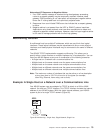
not have a specific route defined. The system allows up to eight default routes, but
each route must have a unique next hop value.
An example of a multiple route table can be found in Figure 63.
TCP/IP Port Restriction
TCP and UDP protocols use ports to identify a unique origin or destination of
communication with an application. Each port is assigned a small integer. You can
configure port information if you want to restrict the use of a TCP or UDP port to
one or more user IDs.
The range of port numbers is from 1 to 65535. However, ports 0-1023 are reserved
as well-known port numbers, which are controlled and assigned by the Internet
Assigned Numbers Authority (IANA). Only those applications that have been
assigned one of these ports should use a number within this range. Refer to the
current Assigned Numbers RFC for a list of the port assignments.
Because this range of port numbers, 0-1023, is reserved for the well-known ports,
they should not be used by user application programs because it could affect the
operation of TCP/IP. For example, restricting the use of ports 21, 23, or 25,
prevents other users from using FTP, TELNET, or SMTP, respectively.
The AS/400 Add TCP/IP Port Restriction (ADDTCPPORT) command allows you to
restrict usage of a single port or a range of ports to a particular AS/400 user profile.
Restricting ports is like allocating ports to a specific user profile. When a socket
application issues the bind() system call, or when a TCP/UDP Pascal API
application issues a call to the TcpOpen, TcpWaitOpen, or UdpOpen function, the
job’s user profile is checked against the list of user profiles that are associated with
Work with TCP/IP Routes
System: SYSNAM003
Type options, press Enter.
1=Add 2=Change 4=Remove 5=Display
Route Subnet Next Preferred
Opt Destination Mask Hop Interface
_ ______________ ______________ ______________
_ *DFTROUTE *NONE 9.4.73.193 *NONE
_ *DFTROUTE *NONE 9.4.73.197 *NONE
_ *DFTROUTE *NONE 9.4.73.196 *NONE
_ 9.4.70.0 255.255.255.0 9.4.73.194 *NONE
_ 9.4.70.0 255.255.255.0 9.4.73.195 *NONE
_ 9.4.70.0 255.255.255.0 9.4.73.198 *NONE
Bottom
F3=Exit F5=Refresh F6=Print list F10=Work with IP over SNA routes
F11= Display type of service F12=Cancel F17=Top F18=Bottom
Figure 63. Work with TCP/IP Routes Display
Chapter 3. TCP/IP: Operation, Management, and Advanced Topics 85


















